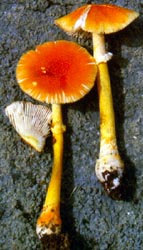| Amanita
rubrovolvata S. Imai "Red Volva Amanita"
Technical description not yet available. BRIEF DESCRIPTION: Fruiting bodies of Amanita rubrovolvata are small to medium-sized, and sometimes very small. The pileus is 20 - 65 mm wide, convex to applanate, sometimes slightly umbonate, red to orange, becoming orange to yellowish at margin, densely covered with red to orange to yellow, farinose to granular volval remnants; the margin is striate (30% to 60% of the radius) and non-appendiculate; and the context is white. The gills are free and white; the short gills are truncate. The stipe 50 - 100 x 5 - 10 mm, subcylindrical or slightly attenuate upwards, with a surface that is cream above the annulus and cream to yellowish below it. The stipe's basal bulb is subglobose, 10 - 20 mm wide, with its upper part covered with red, orange to yellow floccose to farinose volval remnants. The annulus is membranous, persistent, with an upper surface that is white and a lower surface having a yellowish tinge and an edge that is red to orange. The spores measure (7.0-) 7.5 - 9.0 (-11.0) x (6.5-) 7.0 - 8.5 (-10.5) Ám and are globose to subglobose and inamyloid. Clamps are not found on the bases of basidia. Originally described from Japan,
this species occurs in China, northern India, Japan,
Nepal, South Korea, and countries of Southeast Asia (for example,
Thailand). Photos: Zhu L. Yang (top, Yunnan Prov., China), Dr. R. P. Bhatt (bottom-left, Uttaranchal State, India), Kamal Semwal (bottom-right, Uttaranchal State). Return to Section Amanita page. Last changed 3 February 2007. |


